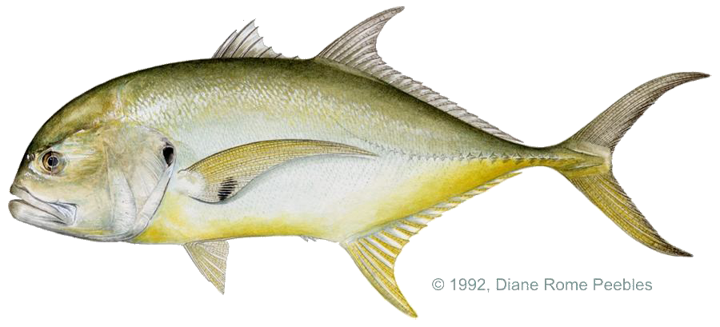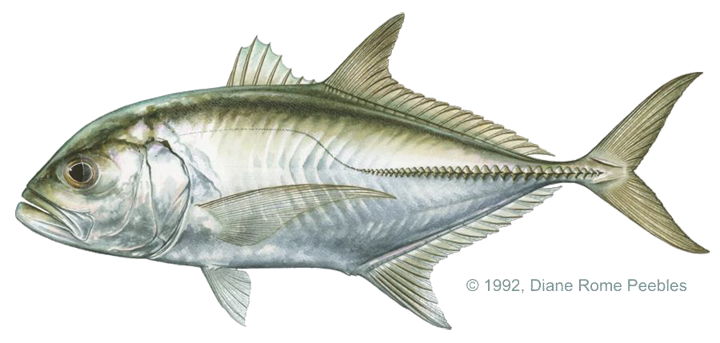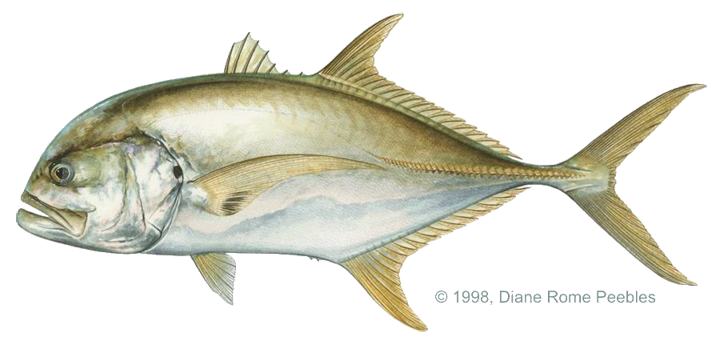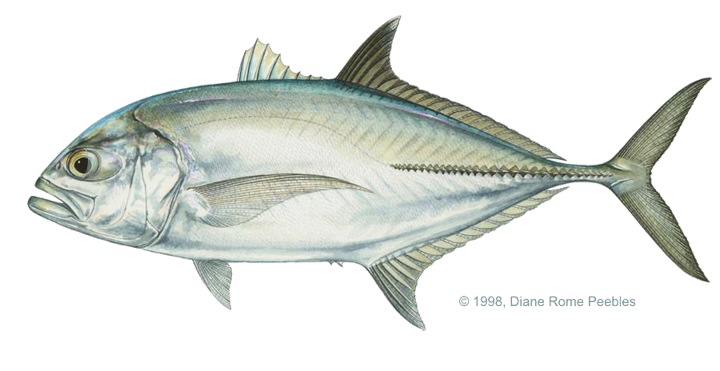Game Fish Identification Reference Guides
Trevally, bluefin
(Caranx melampygus)
(Caranx melampygus)
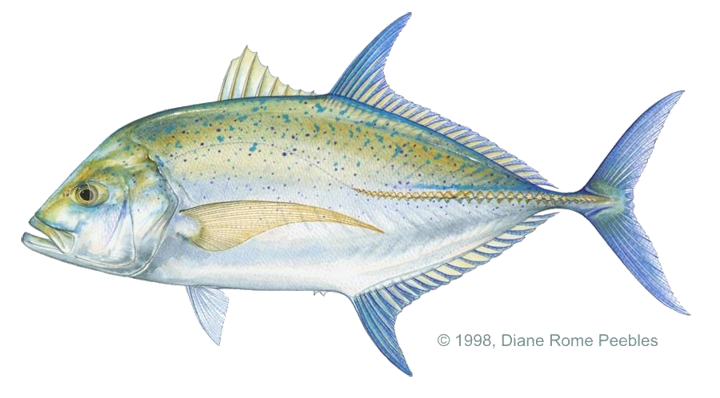
Cuvier & Valenciennes, 1833; CARANGIDAE FAMILY; also called blue spotted jack, starry jack, blue crevally, omilu, bluefin kingfish
The bluefin trevally is widely distributed in the tropical and subtropical waters of the Indian and Pacific oceans. It can be found on the Pacific coast of America from Cabo San Lucas on the southern tip of Baja, California, Mexico, and the Islas Revillagigedos and Tres Marias to Panama. It is common throughout Hawaii and Polynesia, occurring in harbors, channels, and on outer reefs. From Australia where it is known along the entire Queensland and northern coasts, it ranges northward through the Philippines and Micronesia to Japan. Young fish are abundant in the bays of Okinawa during September. Schools of thousands gather to spawn at the southern tip of Peleliu, in Palau, during the new moon in April. C. melampygus is also known from east Africa, the Ryukus, Mauritius, New Caledonia, India, Sir Lanka, Indonesia and Papua New Guinea. It almost certainly occurs in other parts of this range as well.
A large species growing to at least 3 ft (1 m) in length, it is among the most beautiful of the jacks or trevallys. In adults the back and flanks are a brilliant turquoise blue, silvery blue, or greenish blue, generously covered with small blue or black spots. The tail and other fins may be an even more striking blue than the body. The anal and dorsal fin lobes often are white tipped and the tail black edged. Young fish lack spots (including the opercular spot), and have a silvery yellow body much like that of any other jack species. Even these juveniles are distinctive with their bright yellow pectoral fins and deep blue second dorsal and anal fins.
Adults are deep bodied and have strong scutes. The dorsal fin is moderately low, with 8 spines plus 1 very small spine ahead of the fin. The second dorsal and anal fins are long with prominent anterior lobes. The tail is deeply forked and the pectoral fins are long and falcate. The sloping forehead of the is distinctive giving this fish a profile that is readily recognizable to those who are familiar with them. Males are slightly larger than females and sexual maturity occurs at a fork length of about 15 in (40 cm).
They frequent deeper lagoon and outer reef waters during the day. In evening they enter harbors, channels, and shallow reef areas to feed, then retreat to the deeper areas. They feed actively on smaller pelagic fishes and other fishes and crustaceans. In the late evening and early morning, they can be caught by surf casters using small fish baits, crustaceans, or lures. They are also taken from boats over the in shore reefs with similar baits and jigs, and with spoons and feathers trolled at 3 to 6 miles per hour.
The flesh is firm and very good table fare, prized over most of the other species of ulua
The bluefin trevally is widely distributed in the tropical and subtropical waters of the Indian and Pacific oceans. It can be found on the Pacific coast of America from Cabo San Lucas on the southern tip of Baja, California, Mexico, and the Islas Revillagigedos and Tres Marias to Panama. It is common throughout Hawaii and Polynesia, occurring in harbors, channels, and on outer reefs. From Australia where it is known along the entire Queensland and northern coasts, it ranges northward through the Philippines and Micronesia to Japan. Young fish are abundant in the bays of Okinawa during September. Schools of thousands gather to spawn at the southern tip of Peleliu, in Palau, during the new moon in April. C. melampygus is also known from east Africa, the Ryukus, Mauritius, New Caledonia, India, Sir Lanka, Indonesia and Papua New Guinea. It almost certainly occurs in other parts of this range as well.
A large species growing to at least 3 ft (1 m) in length, it is among the most beautiful of the jacks or trevallys. In adults the back and flanks are a brilliant turquoise blue, silvery blue, or greenish blue, generously covered with small blue or black spots. The tail and other fins may be an even more striking blue than the body. The anal and dorsal fin lobes often are white tipped and the tail black edged. Young fish lack spots (including the opercular spot), and have a silvery yellow body much like that of any other jack species. Even these juveniles are distinctive with their bright yellow pectoral fins and deep blue second dorsal and anal fins.
Adults are deep bodied and have strong scutes. The dorsal fin is moderately low, with 8 spines plus 1 very small spine ahead of the fin. The second dorsal and anal fins are long with prominent anterior lobes. The tail is deeply forked and the pectoral fins are long and falcate. The sloping forehead of the is distinctive giving this fish a profile that is readily recognizable to those who are familiar with them. Males are slightly larger than females and sexual maturity occurs at a fork length of about 15 in (40 cm).
They frequent deeper lagoon and outer reef waters during the day. In evening they enter harbors, channels, and shallow reef areas to feed, then retreat to the deeper areas. They feed actively on smaller pelagic fishes and other fishes and crustaceans. In the late evening and early morning, they can be caught by surf casters using small fish baits, crustaceans, or lures. They are also taken from boats over the in shore reefs with similar baits and jigs, and with spoons and feathers trolled at 3 to 6 miles per hour.
The flesh is firm and very good table fare, prized over most of the other species of ulua













